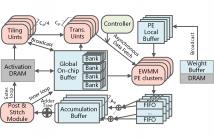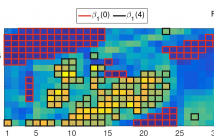
- Read more about AN EFFICIENT METHOD FOR GENERIC DSP IMPLEMENTATION OF DILATED CONVOLUTION
- 1 comment
- Log in to post comments
Dilated convolution is a well-known technique used in neural networks algorithms in AI/ML applications to increase receptive-field under analysis. Dilated convolution layer has an inherent property of capturing wider context in an image and long-term temporal characteristics in an audio signal. In this paper we propose a scheme that allows efficient/generic implementation of 2D dilated convolution and stride on typical DSPs where the instruction sets are well tuned for standard 1D and 2D filtering and convolution operations.
- Categories:
 26 Views
26 Views
- Read more about Low Complexity SLM for OFDMA System with Implicit Side Information
- 1 comment
- Log in to post comments
- Categories:
 8 Views
8 Views
- Read more about Spiking neural networks trained with backpropagation for low power neuromorphic implementation of voice activity detection
- Log in to post comments
Recent advances in Voice Activity Detection (VAD) are driven by artificial and Recurrent Neural Networks (RNNs), however, using a VAD system in battery-operated devices requires further power efficiency. This can be achieved by neuromorphic hardware, which enables Spiking Neural Networks (SNNs) to perform inference at very low energy consumption. Spiking networks are characterized by their ability to process information efficiently, in a sparse cascade of binary events in time called spikes.
- Categories:
 118 Views
118 Views
- Read more about HARDWARE-FRIENDLY COMPRESSIVE IMAGING BASED ON RANDOM MODULATIONS & PERMUTATIONS FOR IMAGE ACQUISITION AND CLASSIFICATION
- Log in to post comments
- Categories:
 19 Views
19 Views
- Read more about CONVEX ENERGY OPTIMIZATION OF STREAMING APPLICATIONS FOR MPSOCS
- Log in to post comments
The energy efficiency of modern MPSoCs is enhanced by complex hardware features such as Dynamic Voltage and Frequency Scaling (DVFS) and Dynamic Power Management (DPM). This paper introduces a new method, based on convex problem solving, that determines the most energy efficient operating point in terms of frequency and number of active cores in an MPSoC. The solution can challenge the popular approaches based on never-idle (or As-Slow-As-Possible (ASAP)) and race-to-idle (or As-Fast-As-Possible (AFAP)) principles.
poster.pdf
- Categories:
 23 Views
23 Views
- Read more about A Low-latency Sparse-winograd Accelerator for Convolutional Neural Networks
- Log in to post comments
Poster.pdf
- Categories:
 82 Views
82 Views
- Read more about Non-Linear Digital Self-Interference Cancellation for In-Band Full-Duplex Radios Using Neural Networks
- Log in to post comments
Full-duplex systems require very strong self-interference cancellation in order to operate correctly and a significant part of the self-interference signal is due to non-linear effects created by various transceiver impairments. As such, linear cancellation alone is usually not sufficient and sophisticated non-linear cancellation algorithms have been proposed in the literature. In this work, we investigate the use of a neural network as an alternative to the traditional non-linear cancellation method that is based on polynomial basis functions.
- Categories:
 49 Views
49 Views
- Read more about DATA-AIDED FAST BEAMFORMING SELECTION FOR 5G
- Log in to post comments
Millimeter wave frequencies paired up with MIMO antennas
employing beamforming are seen as critical enablers of next gen-
eration networks. However, selecting the most beneficial beamform-
ing weights in a codebook-enabled downlink transmitter is a lengthy
task, as the existing methods rely on some form of channel mea-
surement. In fact, if the used codebook is too large, the traditional
methods might fail to select an appropriate entry within the channel
coherence time.
In this paper, a new method to assist the beam selection is pro-
poster.pdf
- Categories:
 22 Views
22 Views
- Read more about LOW COMPLEXITY IMAGE FUSION IN BAYER DOMAIN USING A MONOCHROME SENSOR AND BAYER SENSOR
- Log in to post comments
Mobile cameras have come a long way since their evolution and have replaced digital still cameras. However, their lowlight photography performance needs significant improvement. Dual camera systems consisting of a monochrome sensor and a Bayer sensor offer us a way to improve the low-light photography. The existing dual camera systems use post-processing methods after Image Signal Processor (ISP) for image fusion which are computationally intensive and use two ISPs. We propose a novel architecture in which the image fusion can be done in Bayer domain prior to the ISP.
- Categories:
 50 Views
50 Views
- Read more about Constrain the Docile CTUs: an In-Frame Complexity Allocator for HEVC Intra Encoders
- Log in to post comments
- Categories:
 9 Views
9 Views